Imaging Response to Therapy
Oral
General Cancer Imaging
Wednesday, 20 June 2018
| S03 |
13:45 - 15:45 |
Moderators: Peter Caravan, Guanshu Liu |
13:45
|
0803.
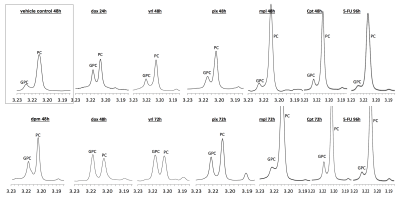 |
 Glycerophosphocholine increase is a reliable surrogate marker of chemotherapy response for various cancer drug treatments in triple-negative breast cancer cells Glycerophosphocholine increase is a reliable surrogate marker of chemotherapy response for various cancer drug treatments in triple-negative breast cancer cells
Menglin Cheng, Vinay Ayyappan, Ruoqing Cai, Caitlin Tressler, Kristine Glunde
MRS-detected total choline is a promising noninvasive surrogate marker of chemotherapy response in breast cancer. We have utilized six widely clinically used cancer chemotherapeutic drugs to treat triple-negative breast cancer cells to elucidate their molecular effects on choline phospholipid metabolism. We employed high-resolution 1H MRS to detect changes in cellular choline metabolites combined with molecular approaches. Glycerophosphocholine increased in triple-negative breast cancer cells following all six types of chemotherapeutic treatment compared to vehicle control, while phosphocholine decreased, increased, or remained stable depending on the specific drug used, making glycerophosphocholine the most reliable surrogate marker of chemotherapy response in our study.
|
13:57
|
0804.
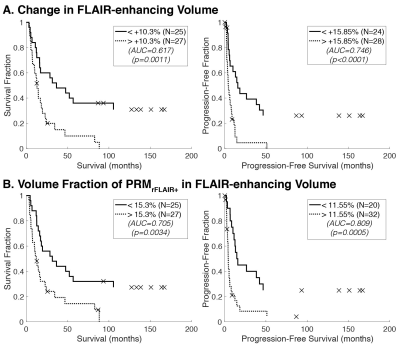 |
 Parametric Response Mapping of Normalized FLAIR MR Images Provides Early Indication of Recurrence Risk in Glioblastoma Parametric Response Mapping of Normalized FLAIR MR Images Provides Early Indication of Recurrence Risk in Glioblastoma
Benjamin Hoff, Craig Galbán, Thomas Chenevert, Gary Luker, Benjamin Lemasson, Timothy Johnson, Brian Ross
Glioblastoma is a particularly malevolent disease, with median expected survival around 14 months. Standard protocols for treatment assessment and recurrence rely on morphological approximations of tumor burden. Recently included by the RANO criteria, T2/FLAIR is now standard in imaging protocols, highlighting edema, presumed to be associated with tumor cell infiltration and critical for accurate description of tumor burden and radiation treatment planning. Advanced methods for early detection of change are underutilized. Application of the Parametric Response Map technique provides greater sensitivity to FLAIR signal changes indicative of tumor progression prior to those detectable by morphological analysis alone.
|
14:09
 |
0805.
 |
 Dynamic contrast enhanced MRI detects pancreatic cancer responses to stroma-directed therapy Dynamic contrast enhanced MRI detects pancreatic cancer responses to stroma-directed therapy
Jianbo Cao, Stephen Pickup, Cynthia Clendenin, Barbara Blouw, David Kang, Peter O'Dwyer, Rong Zhou
Stroma-targeted treatments of pancreatic ductal carcinoma (PDA) has been widely investigated, but there is no imaging method that has been validated for early and noninvasive monitoring of the tumor responses to stroma-directed treatments. Here we treated murine PDA models with an investigational drug, PEGPH20, which removes a stroma component called hyaluronan. We examined whether DCE-MRI can characterize the treat responses. Our results demonstrated that this technique can detect stromal changes as early as 24 h post treatment, and the MRI results are corroborated with HA-staining. Further validation and potential clinical translation are warranted.
|
14:21
 |
0806.
 |
 In vivo monitoring of intracellular pO2 in response to CAR T cell immunotherapy against glioma In vivo monitoring of intracellular pO2 in response to CAR T cell immunotherapy against glioma
Fanny Chapelin, Wenlian Zhu, Hideho Okada, Eric Ahrens
We explore the temporal dynamics of tumor intracellular partial pressure of oxygen (pO2) in a murine glioma model receiving human chimeric antigen receptor (CAR) T cell immunotherapy. Tumor cells were intracellularly labeled with perfluoro-crown-ether (PCE) nanoemulsion ex vivo before flank injection in mouse. The spin-lattice relaxation rate (R1) of PCE is linearly proportional to the local oxygen concentration, enabling longitudinal in vivo measurement of absolute pO2 values. Our results indicate that CAR T cell therapy induces significant tumor pO2 increase peaking three days post-intravenous injection and correlates to tumor growth reduction.
|
14:33
|
0807.
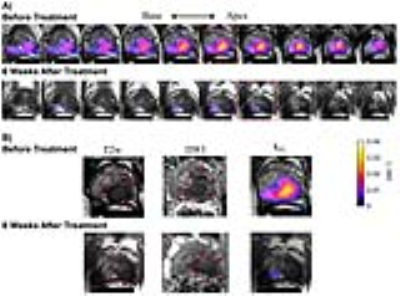 |
 Hyperpolarized-13C Imaging of Treatment Responses on Prostate Cancer Patients using 3D Dynamic CS-EPSI Techniques Hyperpolarized-13C Imaging of Treatment Responses on Prostate Cancer Patients using 3D Dynamic CS-EPSI Techniques
Hsin-Yu Chen, Peder Larson, Jeremy Gordon, Robert Bok, Marcus Ferrone, Mark van Criekinge, Lucas Carvajal, Natalie Korn, Rahul Aggarwal, Pamela Munster, Sarah Nelson, John Kurhanewicz, Daniel Vigneron
Two unmet clinical needs facing the management of prostate cancer are to determine the best treatment for individual patients and to evaluate therapy response. In this study, we applied 3D dynamic imaging technique using hyperpolarized 13C nuclei to non-invasively probe prostate cancer metabolism. Pyruvate-to-lactate conversion kPL correlated well with biopsy and histological finding in pre-surgery prostate cancer patients. kPL values dramatically decreased in a patient 6 weeks into androgen-deprivation therapy with associated PSA decrease, indicating early treatment response. A non-responder patient with castration-resistant cancer exhibited high kPL one month after treatment that correlated with clinical progression.
|
14:45
|
0808.
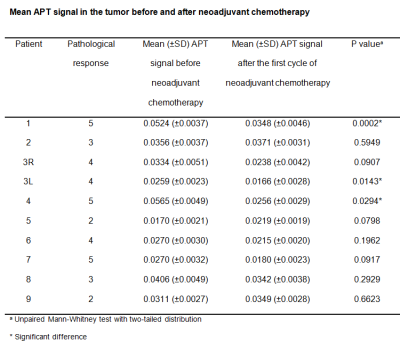 |
 Amide chemical exchange saturation transfer at 7T: A possible biomarker for detecting early response to neoadjuvant chemotherapy in breast cancer patients Amide chemical exchange saturation transfer at 7T: A possible biomarker for detecting early response to neoadjuvant chemotherapy in breast cancer patients
Erwin Krikken, Vitaliy Khlebnikov, Moritz Zaiss, Rajni Jibodh, Paul van Diest, Peter Luijten, Dennis Klomp, Hanneke van Laarhoven, Jannie Wijnen
Neoadjuvant chemotherapy (NAC) has an important role in the treatment of breast cancer and the need for early detection of treatment response is high. Therefore we investigated the feasibility of using APT CEST at 7T as a biomarker for this purpose. Ten lesions were included and APT signal before and after the first cycle of NAC were correlated to the pathological response. Significant differences were found in APT signal corresponding with the pathological response. These results suggest that APT CEST may be used to predict the response to NAC treatment in an early stage.
|
14:57
|
0809.
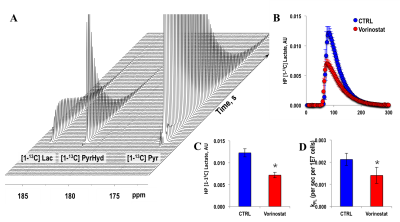 |
 Hyperpolarized 13C MRSI monitoring of response to HDAC inhibition in glioblastoma Hyperpolarized 13C MRSI monitoring of response to HDAC inhibition in glioblastoma
Marina Radoul, Myriam Chaumeil, Pia Eriksson, Chloe Najac, Pavithra Viswanath, Mark Kelly, Anne Marie Gillespie, Joydeep Mukherjee, Russell Pieper, Sabrina Ronen
Treatment of glioblastoma (GBM) is comprised of maximum safe surgical resection, radiotherapy and chemotherapy with Temozolomide. Nonetheless, the median survival of GBM patients is only 15 months with five-year survival rate of only 5.5%. Vorinostat, the clinically relevant histone deacetylase (HDAC) inhibitor, is a novel drug that inhibits cell proliferation and induces apoptosis in solid tumors. Following Vorinostat treatment, we show a significant decrease in hyperpolarized [1-13C] lactate-to-pyruvate ratio that was associated with enhanced survival of glioblastoma-bearing mice. This highlights the potential of hyperpolarized 13C MRSI for monitoring response to a type of anticancer therapy previously unexplored in GBM patients.
|
15:09
 |
0810.
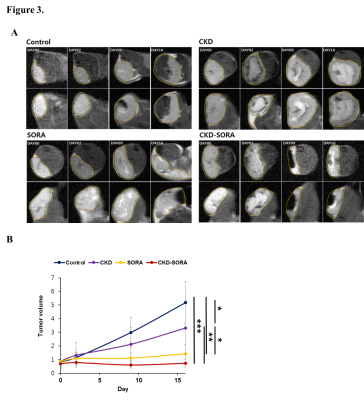 |
 Efficacy of oral CKD-516 in combination with sorafenib on hepatocellular carcinoma using MRI and optical imaging Efficacy of oral CKD-516 in combination with sorafenib on hepatocellular carcinoma using MRI and optical imaging
Su Jung Ham, Jeeheon Kang, Yoonseok Choi, Keun Ho Ryu, Soo Jin Kim, Sang-Tae Kim, Jinil Kim, Chul Woong Woo, Ho-jin Kim, Jaeim Kwon, Do-Wan Lee, Seul-I Lee, Dong Cheol Woo, Kyung Won Kim
We used an oral form of CKD-516 and designed a combination experiment with sorafenib. BLI tumor viability measurement showed CKD-516 was effective in combination with sorafenib, but there was only a slight improvement when treated alone. By MRI, the CKD-516 group showed notable intratumoral hemorrhage and central necrosis from the early stage of treatment. By IHC, CKD-516 was advantageous in collapsing blood vessels in tumor tissue, and was more effective when treated in combination with sorafenib. Therefore, oral CKD-516 was advantageous over sorafenib in terms of vascular disrupting ability, and combination of CKD-516 with sorafenib reduced the rebound phenomenon.
|
15:21
|
0811.
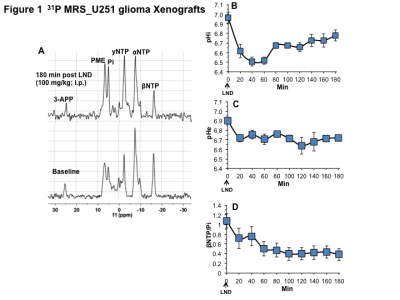 |
 Effect of lonidamine on response to temozolomide in a human glioma model Effect of lonidamine on response to temozolomide in a human glioma model
Kavindra Nath, Jeffrey Roman, Lili Guo, David Nelson, Mary Putt, Stepan Orlovskiy, Ewere Azagidi, Violet Tu, Dennis Leeper, Marco Paggi, Yancey Gallespie, Corinne Griguer, Ian Blair, Jerry Glickson
The treatment of glioblastoma multiforme (GBM) includes temozolomide (TMZ) chemotherapy concurrent with radiotherapy. Lonidamine (LND), an inhibitor of monocarboxylate transporters 1&4, the mitochondrial pyruvate carrier, and complex II, is shown here to potentiate TMZ-induced growth inhibition of U251 glioma cells. Through LC-Mass Spectrometry of cells and 31P and 1H MRS of U251 xenografts, we identified mechanisms of this potentiation, including tumor-selective inhibition of bioenergetics (βNTP/Pi) and simultaneous acidification (intracellular pH and lactate) which may inhibit enzymes contributing to TMZ resistance such as glutathione-S-transferase and O6-methylguanine DNA methyltransferase (MGMT). LND may improve the current care of glioma patients and potentially overcome TMZ resistance.
|
15:33
|
0812.
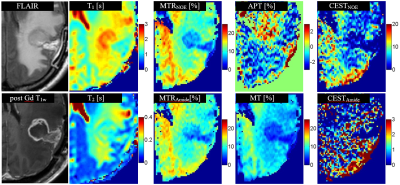 |
 Evaluating Therapeutic Response of Glioblastoma (GBM) with Chemical Exchange Saturation Transfer (CEST) Evaluating Therapeutic Response of Glioblastoma (GBM) with Chemical Exchange Saturation Transfer (CEST)
Hatef Mehrabian, Sten Myrehaug, Hany Soliman, Arjun Sahgal, Greg Stanisz
Early assessment of glioblastoma (GBM) response to standard 6-week chemo-radiation enables changing or adjusting therapy in patients with progressive tumors. Chemical Exchange Saturation Transfer (CEST) probes the concentration and exchange of labile proteins and peptides in ht tumor and is more sensitive to treatment-induced effects. CEST was capable of differentiating progressors from non-progressors as early as two weeks into the treatment. Moreover, certain CEST metrics (i.e. MTRNOE, MTRAmide, CESTNOE) were capable of characterizing GBM aggressiveness even before the start of the treatment.
|
|












